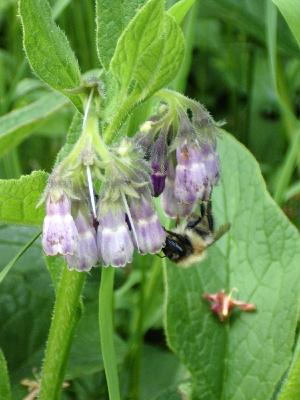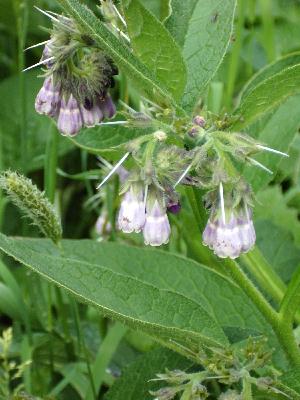Comfrey (Symphytum officinale)
By Lynne Tann-Watson
Other names: Knitbone, boneset, bruisewort, blackwort and many others.

Comfrey is a native perennial found growing in ditches, damp hedgerows and woods. It grows in large clumps up to three or four feet tall and has long, pointed, slightly hairy, oval leaves which can irritate the skin in some people. The flowers are bell-shaped and purple-blue to pink or occasionally white. They appear from May to September. The root is a long tap-root which goes very deep, sometimes as much as 10', and can be very hard to get rid of, as any small piece of root will grow.
History
It is believed to have been brought to Britain by the crusaders.
The name comfrey comes from the Latin 'confevre' meaning 'to grow together' and Symphytum comes from the Greek 'symphyo' meaning 'to unite'. Both names indicate the wonderful powers of the herb to speed the regrowth of cells and to mend breaks and wounds.
Folklore
Carrying it, especially in the shoe is supposed to ensure safety while traveling, and placing it in your suitcases will avoid their loss.
Cultivation
The root can be divided in spring or autumn, or the clumps divided. It likes a damp soil and shady conditions.
Part used
The dried root or the leaves, fresh or dried, though they are better fresh.
Harvesting
The leaves should be gathered in June and July and the root dug up from October to March.

Culinary uses
Comfrey is not much used in cooking, though the leaves can be steamed or lightly boiled as a vegetable, or coated in batter and fried.
Medicinal uses
Comfrey contains allantoin, a cell proliferant which repairs damaged tissue, so it is the best of all herbs for applying to bruises, sprains and fractures. It is particularly useful for such breaks as toes, ribs or hairline fractures where it is not possible to bind the break.
It has been used internally for duodenal ulcers, ulcerative colitis and bronchitis, though its use internally has been restricted in some countries as it may cause liver damage and tumours. It can help heal acne, boils and psoriasis. If using it as a wound healer, caution should be exercised for if the wound is deep because it may encourage growth of surface tissue before the wound has healed deeper down, thus allowing abscesses to develop. Care should also be taken that any wound is very clean so that the rapid healing does not trap dirt inside the wound.
As an anti-inflammatory, comfrey is very useful, and an infused oil, ointment or poultice can be applied to arthritic joints, conditions such as tennis elbow and inflamed bunions. It also reduces swelling and has been used to treat gout, phlebitis and burns. Applied to scars it can help to diminish them.
Other uses
Older leaves may be wilted and used as animal feed because they are high in protein. As a garden herb it is a wonderful compost plant adding many nutrients. A liquid fertilizer can be made by drilling a hole in the bottom of a lidded bucket and standing on bricks with a bowl underneath. The bucket is then filled with comfrey leaves, which are left to rot. The resulting liquid will drip into the container and can be stored in a bottle. This is very concentrated and can be diluted and used as a plant feed.
It can also be used as a mulch around the base of plants and placed in the bottom of a trench before planting potatoes. If you are growing runner beans up a 'wigwam', bury comfrey leaves in the centre for bigger, healthier beans.
The leaves and flowers produce yellow and orange dyes for wool and cloth, depending on the mordant used.
